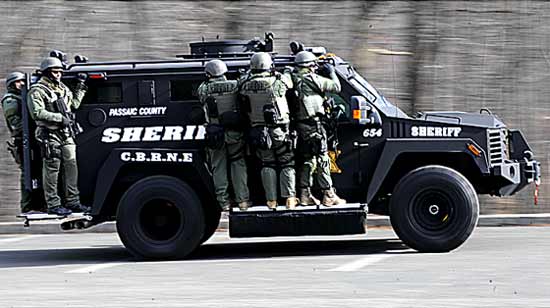Not really a technical thing, but is something that I have to deal with as a self-employed contractor. The big change for me between being an employee versus someone who is self-employed is the amount of driving I do on a day-to-day basis. The group of engineers that I work with covers an area from New York City all the way up to the Canadian border. On any given day, I can be in Bridgeport CT, or Albany, NY or Burlington, VT, or White Plains, NY. The miles pile up quickly.
While out driving around, I get to see many new things. For example, yesterday I drove by the County Sheriff’s car:

Something has changed, but I can’t quite put my finger on it.
The fact that I drive so many miles means that there will almost certainly be some interaction with local law enforcement, especially on that late-night trip to or from a transmitter site. As one State Trooper once put it, nothing good happens after 11 pm, which seemed to be enough to trigger reasonable suspicion and a traffic stop.
Of course, the police officers executing traffic stops are doing their jobs and the best course of action is to cooperate and maintain a polite, professional disposition. Usually, a traffic stop goes something like this:
While driving down the road, you notice a police car behind you. At some point, the lights will come on and you pull over, the police car pulls up behind you. At this point, you roll down the driver-side window, put the car in park (or neutral), and turn off the engine. Do not start rooting around for the registration, get out your wallet, unlatch your seat belt, or anything else, just sit there. The police officer will run your plate, which may take a few minutes. Then, after some period of time, he (or she) will get out of the police car and approach your vehicle on the driver’s side. When you see him approach, place both hands on the steering wheel, so that he (or she) can see them. The exchange will go something like this:
Police officer: Do you know why I pulled you over?
Yourself: No, I do not. (That is always the reply, even if you have a good idea why you were pulled over)
PO: You were (speeding, running a stop sign, red light or the general crossing road lines, unable to maintain lanes, unsafe lane change, etc) (fill in the blank).
Yourself: I was not aware of that.
From here, the interaction can take any number of routes; you may be able to explain what was going on, he may let you off with a warning, or you may get a ticket. As the driver, you will have to gauge the situation. Many times, I have found the best course is to explain that you are a radio (or TV) engineer on your way to or from some specific emergency somewhere. Many times, this will be enough, so long as the police officer does not suspect you of drinking or something similar.
Other times, the generic “you crossed the white (or yellow) line” will be used for a fishing expedition and he is looking for drunk driving, warrants, drugs, or something else to arrest you for. The most important thing to remember is not to give him that reason.
The police officer will ask you for your license and registration, he may ask you to step out of the car, take a field sobriety test, ask questions about items in the car, etc. Answer the specific question and no more, do not get chatty, volunteer information, etc.
If a traffic citation is issued, follow the directions, mail it in on time, and plead not guilty. Some form of trial will take place, often, before the proceeding, the prosecuting attorney or police officer will approach you and offer a plea to some lesser charge. To avoid wasting a lot of time on a trial, make the best deal possible and pay the fine.
On the other hand, if there is time to spare, go ahead with the trial. There are many ways to get out of a speeding ticket, especially if RADAR was used in the traffic stop. The law of sines is a good way to shoot holes in a police officer’s RADAR testimony. I like this one, because, in order for RADAR to be accurate, the measurement must be taken from dead ahead. Any angle to either side and the relative speed of the vehicle to the RADAR gun is reduced as a function of the sine of the angle. The greater the angle, the less the relative speed. Other things like calibration procedures (which can be checked), the last time the instrument was calibrated, the time interval between the use of the RADAR gun and passage of vehicle(s), did the police officer lose sight of your vehicle, etc.
I have gone to trial twice for speeding tickets, lost one because the system was rigged (this was on Guam), and won the other because the police officer lost sight of my vehicle while he turned around to catch me. That was on a back road, where there were multiple places to enter or exit the roadway and I was something like two miles away from the point of the infraction.
With any profession that requires a lot of driving, especially late at night, some interaction with local law enforcement will take place. Be polite, use common sense, be professional, don’t take any shit but don’t create any bigger problems either.
